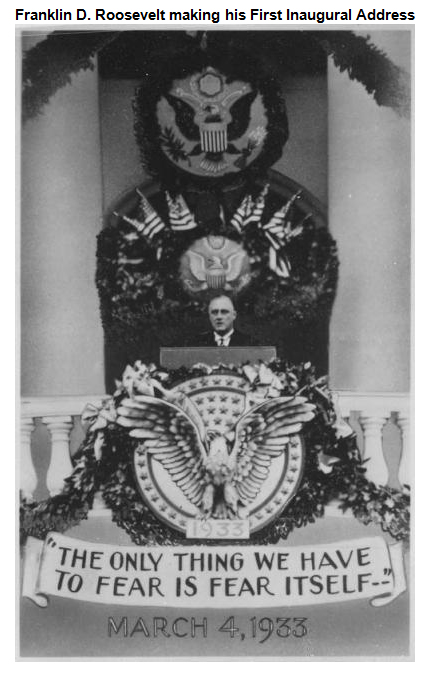
Source: 48224291, Franklin Delano Roosevelt Library and Museum

Source: 48224291, Franklin Delano Roosevelt Library and Museum
![]() Franklin Delano Roosevelt took office on March 4, 1933, at the height of the nation’s most devastating economic depression. The document below is the first page of FDR’s first inaugural address. Read the document first and then click on it and read the highlighted parts.
Franklin Delano Roosevelt took office on March 4, 1933, at the height of the nation’s most devastating economic depression. The document below is the first page of FDR’s first inaugural address. Read the document first and then click on it and read the highlighted parts.
Click on the link below to listen to the full speech.
![]() President Roosevelt's Inaugural Speech
President Roosevelt's Inaugural Speech
After reading the highlighted portions of the document, answer the following questions in your notes.
Interactive popup. Assistance may be required.
The present situation that Roosevelt refers to is the Great Depression.
Interactive popup. Assistance may be required.
Roosevelt is saying that the only thing Americans have to fear at this point (the impact of the Great Depression) is the fear of doing something new and making changes to the economic condition of the country.
Interactive popup. Assistance may be required.
Roosevelt was referring to the changes of the 1920s, changed values in the roles of men and women, higher taxes, and the abuse of credit. Those are a few of the issues of the 1920s that impacted the 1930s.
The first hundred days of every U.S. president's term is a defining period. Many presidents create policies, appoint and nominate staff to positions, and make other crucial decisions. In the first hundred days of FDR’s first term, he focused mainly on the issues surrounding the Great Depression.
By 1933, unemployment had reached 25 percent, the highest rate since the stock market crashed in 1929. Americans were losing jobs or taking severe pay cuts. Almost every bank in America closed their offices. A massive drought plagued the Plains and surrounding regions for up to ten years. The Dust Bowl, as it was called, impacted not only the people living in those areas, but the rest of the country.
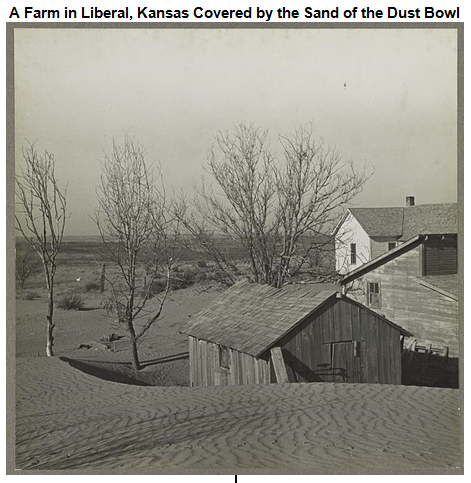
Source: Liberal (vicinity), Kan. Soil blown by dust bowl winds piled up in large drifts on a farm, Library of Congress
According to the National Archives, Roosevelt planned to address the economic issues with the 3 Rs: relief for the needy, economic recovery, and financial reform. Roosevelt used his first hundred days to fulfill his campaign promise to give Americans a “New Deal.” Roosevelt consulted a group of scholars, economists, and theorists called a brain trust, and discussed with them a plan of action to address the depression. Congress fully supported Roosevelt in his plans.
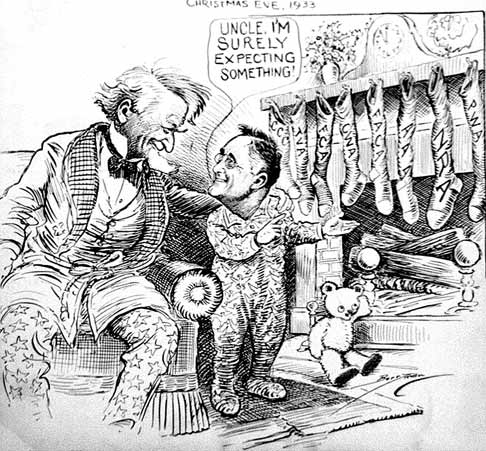
Source: Cartoon, New Deal 1, Baruch College-CUNY
His first action was to pass the Emergency Banking Act of 1933. Passed on March 9, 1933, the purpose of this act was to end the banking panic and help restore the public’s faith in the banking system. The government shut down all banks in the country and only reopened those (about 2/3 of all banks) that were deemed healthy enough to reopen. Congress then formed the Federal Deposit Insurance Corporation (FDIC), which insured bank deposits up to $5,000. Soon after passing this act and creating the FDIC, people regained their confidence in the U.S. banking system and began to deposit money into banks again. The FDIC is one of several New Deal agencies that are still in effect today. Today’s FDIC insures depositors up to $250,000.
The Emergency Banking Act was the first of many that still affects the lives of Americans today. The list below represents part of the New Deal legislation passed during the first hundred days.
March 9 |
Emergency Banking Act |
List adapted from Roosevelt Institute
Here’s a thought: What does the above list indicate about how quickly Roosevelt was trying to address the issues that the United States faced upon his election?

In 1935, Roosevelt created a new slate of alphabet agencies, many of which are still impacting American lives today. There are so many agencies and acts involved in the New Deal; it may be hard to remember them all.
Click on the link below to access the New Deal periodic table, a tool to assist you with understanding the New Deal legislation.
Use the periodic table to answer the following questions on this chart.
Click here to compare your chart.
The legacy of Roosevelt’s presidency can still be seen in the lives of Americans today. Several of the New Deal Programs are still in existence today.
![]() The statements below describe one of the alphabet agencies of the New Deal. Read each statement and place it next to the tile that represents the correct agency.
The statements below describe one of the alphabet agencies of the New Deal. Read each statement and place it next to the tile that represents the correct agency.
While many felt that Roosevelt’s New Deal programs were good for the economic recovery of the United States, there was strong opposition to the programs. First, there was resentment among the wealthiest people of the United States. Roosevelt had imposed higher taxes on the wealthiest communities.
Next, there were politicians and activists who felt the programs did not work, and opposed the New Deal measures. Many of these people had nationwide appeal and influenced many Americans. By the time of the presidential election of 1936, the people reelected Roosevelt by a landslide. This proved that most voters were pleased with Roosevelt and the New Deal.
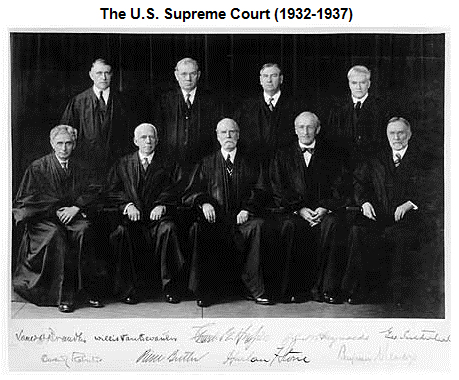
Source: Supreme Court 1932, Mhym, Wikimedia
Finally, the Supreme Court proved to be Roosevelt’s strongest opponents. Many of the justices felt that Roosevelt had no right to impose his laws on the states. Through a series of hearings, the court decided that 11 of the 16 New Deal programs were illegal or unconstitutional. The Supreme Court reversed measures that would raise the minimum wage and increase jobs.
Roosevelt feared that the progress he made towards recovering the economy and providing relief for the poor would be completely reversed. Upon his 1936 reelection, Roosevelt proposed a reorganization of the Supreme Court, also known as court-packing. He aimed to force the justices who opposed him to resign by flooding the court with appointed justices who supported his plans.
Roosevelt planned to add one justice for every sitting justice who was over the age of 70. Additionally, he proposed a lucrative pension program for federal judges who had retired. However, the plan did not work, in fact, it caused many people to think that FDR was overstepping his authority. Some feared that the president was ignoring the separation of powers that the constitution provided.
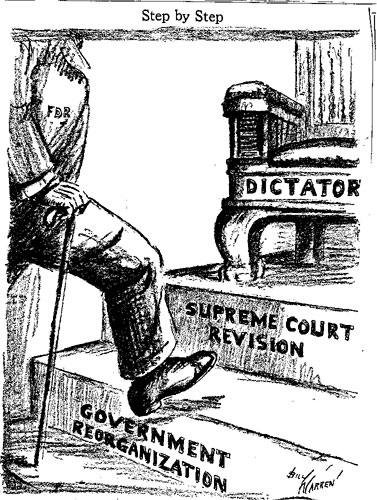
Source: Step-by-Step, Modern American History, Baruch College, CUNY
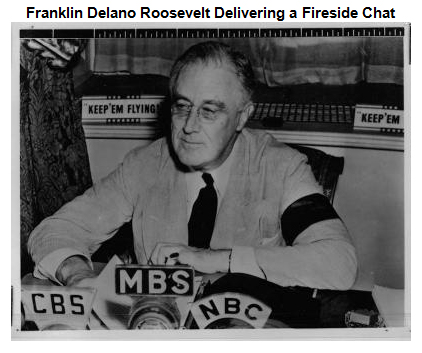
Source: 48223713, Franklin Delano Roosevelt Library and Museum
President Roosevelt used the radio as a means to stay connected to the American people and discuss the major issues that the country was facing. These fireside chats, as they were called, allowed the president direct access to the people.
Read an excerpt below from Roosevelt’s Fireside Chat regarding court-packing. Answer the following questions in your notes.
"What is my proposal? It is simply this: whenever a judge or justice of any federal court has reached the age of seventy and does not avail himself of the opportunity to retire on a pension, a new member shall be appointed by the president then in office, with the approval, as required by the Constitution, of the Senate of the United States. That plan has two chief purposes. By bringing into the judicial system a steady and continuing stream of new and younger blood, I hope, first, to make the administration of all federal justice, from the bottom to the top, speedier and, therefore, less costly; secondly, to bring to the decision of social and economic problems younger men who have had personal experience and contact with modern facts and circumstances under which average men have to live and work. This plan will save our national Constitution from hardening of the judicial arteries. . .”
-Excerpt from FDR Fireside Chat on March 9, 1937
Click on the link below to listen to the full fireside chat.
Analyzing the excerpt: What are the two reasons Roosevelt gave Americans for his court-packing proposal?

The court-packing idea never got off the ground, but the pension plan for retiring federal justices was passed. The justices who opposed Roosevelt took advantage of the new pension plan that he had proposed. Furthermore, the Supreme Court began to change its views on the New Deal, upholding its measures in various cases. By 1941, Roosevelt was able to replace five Supreme Court justices.